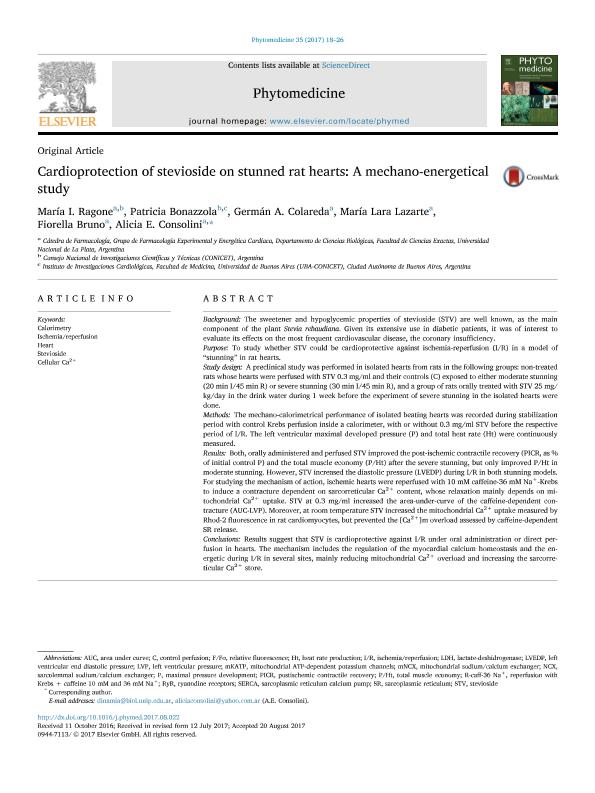Mostrar el registro sencillo del ítem
dc.contributor.author
Ragone, María Inés

dc.contributor.author
Bonazzola, Patricia

dc.contributor.author
Colareda, German Andres

dc.contributor.author
Lazarte, María Lara
dc.contributor.author
Bruno, Fiorella
dc.contributor.author
Consolini, Alicia Elvira

dc.date.available
2018-04-12T13:24:28Z
dc.date.issued
2017-11
dc.identifier.citation
Ragone, María Inés; Bonazzola, Patricia; Colareda, German Andres; Lazarte, María Lara; Bruno, Fiorella; et al.; Cardioprotection of stevioside on stunned rat hearts: A mechano-energetical study; Elsevier Gmbh; Phytomedicine; 35; 11-2017; 18-26
dc.identifier.issn
0944-7113
dc.identifier.uri
http://hdl.handle.net/11336/41833
dc.description.abstract
Background: The sweetener and hypoglycemic properties of stevioside (STV) are well known, as the main component of the plant Stevia rebaudiana. Given its extensive use in diabetic patients, it was of interest to evaluate its effects on the most frequent cardiovascular disease, the coronary insufficiency. Purpose: To study whether STV could be cardioprotective against ischemia-reperfusion (I/R) in a model of “stunning” in rat hearts. Study design: A preclinical study was performed in isolated hearts from rats in the following groups: non-treated rats whose hearts were perfused with STV 0.3 mg/ml and their controls (C) exposed to either moderate stunning (20 min I/45 min R) or severe stunning (30 min I/45 min R), and a group of rats orally treated with STV 25 mg/kg/day in the drink water during 1 week before the experiment of severe stunning in the isolated hearts were done. Methods: The mechano-calorimetrical performance of isolated beating hearts was recorded during stabilization period with control Krebs perfusion inside a calorimeter, with or without 0.3 mg/ml STV before the respective period of I/R. The left ventricular maximal developed pressure (P) and total heat rate (Ht) were continuously measured. Results: Both, orally administered and perfused STV improved the post-ischemic contractile recovery (PICR, as % of initial control P) and the total muscle economy (P/Ht) after the severe stunning, but only improved P/Ht in moderate stunning. However, STV increased the diastolic pressure (LVEDP) during I/R in both stunning models. For studying the mechanism of action, ischemic hearts were reperfused with 10 mM caffeine-36 mM Na+-Krebs to induce a contracture dependent on sarcorreticular Ca2+ content, whose relaxation mainly depends on mitochondrial Ca2+ uptake. STV at 0.3 mg/ml increased the area-under-curve of the caffeine-dependent contracture (AUC-LVP). Moreover, at room temperature STV increased the mitochondrial Ca2+ uptake measured by Rhod-2 fluorescence in rat cardiomyocytes, but prevented the [Ca2+]m overload assessed by caffeine-dependent SR release. Conclusions: Results suggest that STV is cardioprotective against I/R under oral administration or direct perfusion in hearts. The mechanism includes the regulation of the myocardial calcium homeostasis and the energetic during I/R in several sites, mainly reducing mitochondrial Ca2+ overload and increasing the sarcorreticular Ca2+ store.
dc.format
application/pdf
dc.language.iso
eng
dc.publisher
Elsevier Gmbh

dc.rights
info:eu-repo/semantics/openAccess
dc.rights.uri
https://creativecommons.org/licenses/by-nc-nd/2.5/ar/
dc.subject
Calorimetry
dc.subject
Cellular Ca2+
dc.subject
Heart
dc.subject
Ischemia/Reperfusion
dc.subject
Stevioside
dc.subject.classification
Inmunología

dc.subject.classification
Medicina Básica

dc.subject.classification
CIENCIAS MÉDICAS Y DE LA SALUD

dc.title
Cardioprotection of stevioside on stunned rat hearts: A mechano-energetical study
dc.type
info:eu-repo/semantics/article
dc.type
info:ar-repo/semantics/artículo
dc.type
info:eu-repo/semantics/publishedVersion
dc.date.updated
2018-04-10T20:31:43Z
dc.journal.volume
35
dc.journal.pagination
18-26
dc.journal.pais
Alemania

dc.description.fil
Fil: Ragone, María Inés. Universidad Nacional de La Plata. Facultad de Ciencias Exactas. Departamento de Ciencias Biológicas; Argentina. Consejo Nacional de Investigaciones Científicas y Técnicas; Argentina
dc.description.fil
Fil: Bonazzola, Patricia. Consejo Nacional de Investigaciones Científicas y Técnicas. Oficina de Coordinación Administrativa Houssay. Instituto de Investigaciones Cardiológicas. Universidad de Buenos Aires. Facultad de Medicina. Instituto de Investigaciones Cardiológicas; Argentina
dc.description.fil
Fil: Colareda, German Andres. Universidad Nacional de La Plata. Facultad de Ciencias Exactas. Departamento de Ciencias Biológicas; Argentina. Consejo Nacional de Investigaciones Científicas y Técnicas; Argentina
dc.description.fil
Fil: Lazarte, María Lara. Universidad Nacional de La Plata. Facultad de Ciencias Exactas. Departamento de Ciencias Biológicas; Argentina
dc.description.fil
Fil: Bruno, Fiorella. Universidad Nacional de La Plata. Facultad de Ciencias Exactas. Departamento de Ciencias Biológicas; Argentina
dc.description.fil
Fil: Consolini, Alicia Elvira. Universidad Nacional de La Plata. Facultad de Ciencias Exactas. Departamento de Ciencias Biológicas; Argentina
dc.journal.title
Phytomedicine

dc.relation.alternativeid
info:eu-repo/semantics/altIdentifier/doi/http://dx.doi.org/10.1016/j.phymed.2017.08.022
dc.relation.alternativeid
info:eu-repo/semantics/altIdentifier/url/https://www.sciencedirect.com/science/article/pii/S0944711317301125
Archivos asociados
